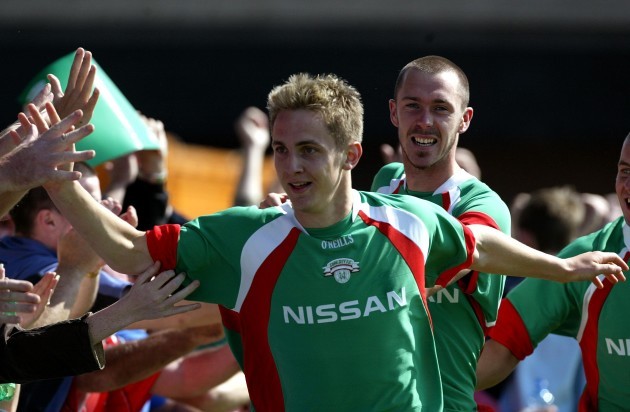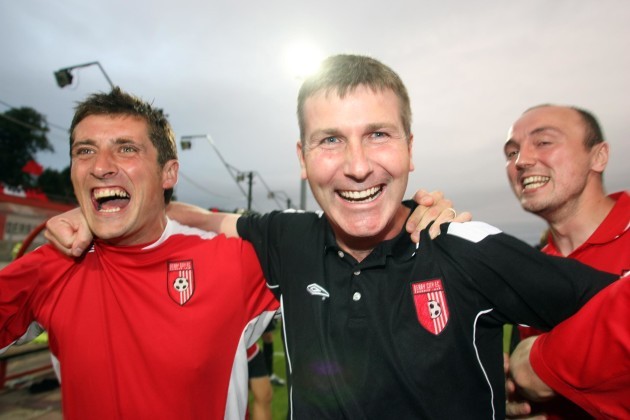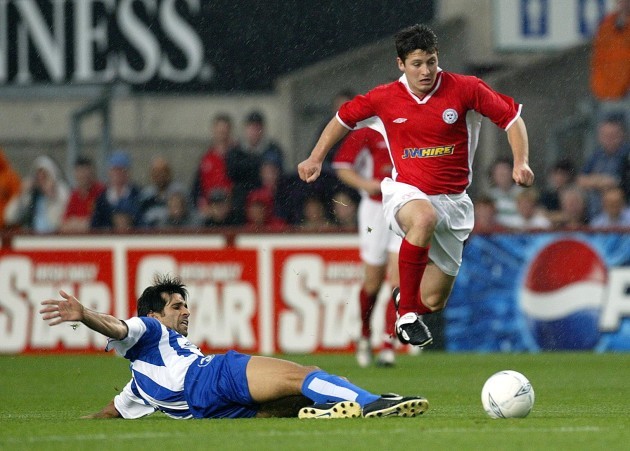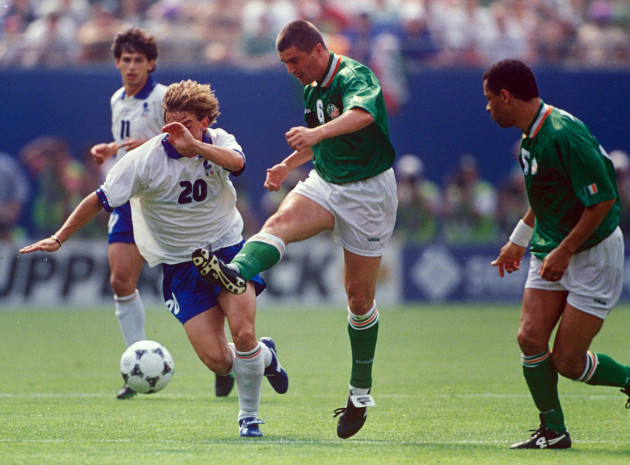In today’s chapter in our series on Irish football, Garry Doyle hears from the title-winning manager who explains why his Dundalk side would give Ireland’s 1994 World Cup team a run for their money and from the club chairman who says the FAI should take a leaf out of the IRFU’s book and put players on central contracts.
SO HERE HE comes, Giovanni Trapattoni, striding with intent through the corridors of the Ernst-Happel-Stadion on this, the final game of his managerial career. September 2013. Navy suit and white cotton shirt. He steps onto the slightly raised platform and names his team, one that contains five League of Ireland graduates.
Sitting in front of a packed press room, he is asked about Ireland’s failure to qualify for the 2014 World Cup at which point he shifts backwards in his chair to allow himself room to wave his hands and reinforce a point. “Austria has a league,” he says, his voice rising with each word. “Sweden has a league. But Ireland! Ireland has no league.”
And so a flock who felt marginalised to begin with, now had an additional sense of persecution. “If this was what the national team manager thought of us, then heaven help us,” Jim Hanley, Longford Town’s chairman, said to The42.
There is irony. No Ireland manager since Liam Tuohy in the ‘70s selected more League of Ireland alumni than Trapattoni. In all 14 players – Seamus Coleman, James McClean, Kevin Doyle, Wes Hoolahan, Shane Long, Stephen Ward, Keith Fahey, David Forde, Damien Delaney, Noel Hunt, Conor Sammon, David Meyler, Daryl Murphy and Paddy Madden, were all capped by the Italian.
And while the emergence of these players from a much-abused League into Premier League and international football clearly provided an injection of credibility, it was another statistic that made people sit up. From the turn of the century, Irish teams started beating clubs from middle-ranking European nations on a regular basis – Russian, Dutch, Croatian, Serbian, Bosnian, Norwegian, Polish, Scottish, Israeli, Finnish and Belarusian teams among the fallers.
But no ‘country with a league’ was embarrassed as often as the blessed Swedes; Malmo, Djurgardens and Hacken all knocked out of Europe by Cork City, a trend that St Pat’s (winners over Elfsborg in 2008) and Derry City (Gothenburg in 2006) carried on.
“I could laugh,” the former St Pat’s manager, John McDonnell, said “when I heard Trapattoni say what he did about our League. This guy offered nothing to the domestic game; took his money and never realised how he got it. Without a competitive League, Fifa wouldn’t sanction a national team. Without a national team, Trapattoni wouldn’t have had the generous salary the FAI paid him for five years.
“I managed St Pat’s against Elfsborg. We beat them and Keith Fahey played Anders Svensson off the park, five years before Svensson turned up in the Aviva to score the winner against Ireland. No League? Give me a break.”
From 2004 to 2006, the League of Ireland got its first big break. For once, all the planets were aligned, as investors decided it was a product worth spending on, as the flow of player traffic came inwards rather than outwards, as managers dared to dream.
The FAI too were looking at the bigger picture – inserting a coach education plan that demanded every Premier Division manager gain his Uefa Pro License certificate.
And the upshot was that the League – in three quick years – underwent a quiet evolution. Gone were the days of 4-4-2 and pot-bellied midfielders. The fitness and tactics geeks had taken over. Full-time football was the rage. Only one manager in the Premier Division was aged over 42.
“The league changed because more modern thinking coaches came into it, men like Pat Fenlon, Paul Doolin, Stephen Kenny, all of whom are exceptional coaches,” says Vinny Perth, manager of the current League champions, Dundalk. “Later, another forward thinking coach, Michael O’Neill, had a huge influence on things too. Now you’ve so many more good coaches involved – and players too are more open to learning because every game is a tactical battle. Twenty years ago it was 4-4-2 versus 4-4-2 and the basic attitude was, if you win eight or nine head-to-heads then you will win the game. It’s a different pre-game discussion now.”
A couple of other things influenced this change, a switch from a winter to summer season as well as the emergence of a new breed of player. “I remember when I started my career in the ‘90s,” says Alan Reynolds, now approaching his 30th year as player and manager in this League. “We lost a relegation play-off in Monaghan and on the way back, the cans were out, lads drinking. That was the culture. After games on a Sunday, we’d go for pints.”
Stephen McGuinness, the head of the players union (PFAI), is from that same generation. The 90s were full of craic. “Cup matches, the thing then was for a slab of beer to be in the dressing room after the game,” McGuinness says. “Pubs put in sponsorship. We went there after matches for pints. Gradually that changed. I remember Pat Dolan when he was in charge of us at St Pat’s. He frequently pointed out the damage of alcohol to us. That was a turning point.”
Vanity is another factor. “Players now,” McGuinness says, “they’ll soon be told in the dressing room if they’re out of shape. Anyone carrying a few pounds would be embarrassed in front of their peers. It’s a serious business.”
Yet it’s also the weirdest of businesses. Some League of Ireland clubs are full-time, some part-time, some amateur. At different stages of this century, various clubs suffered financial meltdowns and when the recession came in the middle of the last decade, a fire-sale began. Future internationals Wes Hoolahan, Stephen Ward and Conor Sammon were sold by various clubs for a collective fee of €235,000.
While this was all happening, clubs were looking over the fence at rugby. This too was a sport whose governing body had to make a large contribution to the Aviva Stadium rebuild. As well as this, they helped oversee the transformation of the RDS from a showjumping arena into a rugby ground and Thomond Park and Ravenhill from antiquated stadiums into modern settings.
They didn’t stop there. Twenty years ago, the idea of the Union using chunks of their income to pay the wages of their players was still being figured out. Yet this is what they have done, year on year, for nearly two decades. Figures released in their last annual statement show how the IRFU spent €56m of their income on ‘professional game costs’ and ‘elite player development’.
“That’s why I really feel we could have had a fully professional league here,” says McGuinness. “The IRFU have spent all that money on players, coaches and academies.”
Hanley, the longest serving chairman in the League of Ireland, is another who believes Irish football can borrow from rugby’s thinking. “Just look what the IRFU have achieved over the last 20 years, central contracting their players, successfully funding the four provinces,” he says. “We have 20 clubs. Full-time football could be sustainable in those 20 clubs if there was a central income coming in from the FAI, say a minimum of €400,000 per club, €8million per year all-in. Clubs could then top up the players wages from that base amount.
“Of course there has to be something in it for the FAI. If they provide this funding, then the clubs have to give the FAI 51 per cent ownership of the players so that if there is a transfer – say another Seamus Coleman going out of Sligo to Everton – then they wouldn’t be selling him for £60,000.
“Central contracting would provide stability as the player would be on a longer-term deal and the selling club would thereby have a stronger negotiating hand. Once the sale goes through, the FAI would then get 51 per cent of the fee which it can reinvest into the central pot, and the selling club – which has the final say on these matters, would get 49 per cent of the sale.
“Now in turn, clubs need to do their bit. You can’t have a full-time playing set-up if you don’t have an administrative structure behind it. But while €8m seems a lot of money – particularly for an association that was on its knees before the government bail-out, look at it another way. Look what the IRFU invested (€45m in professional game costs in 2018/19, €11m in their elite player development programme) last year. How come they have been able to do that when 20 years ago, they had the same net turnover, give or take, as the FAI?”
**
For one reason or another, huge swathes of the Irish sporting public just haven’t invested time and love into the League of Ireland, even though there has been a marked improvement in quality across the last 20 years.
The upgrade, Perth argues, stems from a tournament no one has ever linked the League with before.
“Compare the 1994 World Cup to the 1998 competition in France,” says Perth. “That latter one saw France’s athletic, powerful athletes play technically brilliant football. Winners create trends in football, always have done, and that French side showed the value of physical conditioning. That gradually seeped into the culture of the League of Ireland. Players take care of themselves properly now. They are impressive athletes. In today’s League of Ireland, a player like me would not get near a top-four team.
“Or to put it another way, in a hypothetical scenario, I wouldn’t be fearful of putting the 2020 Dundalk team up against the 1994 Ireland national team. Obviously, talent wise, that 1994 Irish team had brilliant players but in terms of their tactical knowledge and conditioning, this Dundalk team are way advanced of where that 1994 Irish team were. It was a different game back then. There was no real pace in the Italian team who lost to Ireland in Giants Stadium.”
That great French ’98 team played with just one recognised striker, a practice which by 2002 was copied by almost all Premier League teams in England, not just Arsenal who already had Dennis Bergkamp, the master of the split-striker role, but even Bolton Wanderers, who bought a key member of that French World Cup winning side, Youri Djorkaeff, and fitted him into their system.
Watching from across the pond, Irish teams also altered their strategy.
“Clubs started using players in the Teddy Sheringham role rather than going for two up front,” Perth says. “Wes (Hoolahan) and (former Ireland international) Alan Moore did that at Shels; Shane Barrett did it for us at Longford; Gary Beckett at Derry, Neale Fenn at Cork and later Bohs.
“Still, there were plenty of games – say when Shels were away to Finn Harps or Derry – when Wes was a sub. In those days, there was a battle to be won first. This was also a period when everyone was searching for a Claude Makélélé type player too. Then Barcelona’s success saw further fashion trends. Coaches over the last 10 to 15 years in Ireland have become really good at adjusting their style of play. Teams have several plans, not just one.
“The game here now is much more tactical than it was. Full backs have become raiders. We saw that with Seamus Coleman when he was at Sligo. Simon Madden and Ian Bermingham fitted that bill; Sean Gannon and Dane Massey have taken it to another level. These days in the League of Ireland, everyone feels the full back can take the game to the opposition.
“I’m not necessarily saying it is a better spectacle than it was but I’d argue it is harder to win matches now than it was 15 years ago. Young hungry coaches have been given the tools to bring the game and players to another level.”
Getting the League to a higher level has never been more important given how the Premier League and Championship, traditionally an outlet for Irish football’s top talent, has become overloaded with global talent. In 2017, a Uefa club licensing report highlighted how 69.2 per cent of Premier League players were foreigners, a higher percentage than any other league in the world. The Championship incidentally ranked sixth.
“Whether we like it or not, we’ve been a development league for the national team,” Perth said. “This was where Seamus Coleman, James McClean, Keith Fahey, Enda Stevens – and many others – started.
“Until – or if – we get to the next stage, we will continue to be that (a development league). We need to get to Bate Borisov, Salzburg, Rosenborg’s level.”
Can it happen? Or will a similar discussion take place a decade from now with different names making pretty much the same points? The problem won’t be the child. It’ll depend on how she’s parented.
*Tomorrow the final chapter in our series focuses on the legacy of most controversial player of the Irish football century: Roy Keane.








